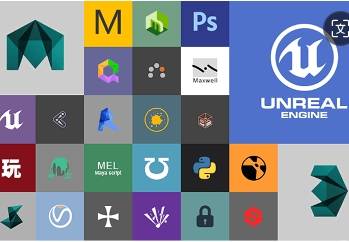Release date:2021, August
Author:Penny de Byl
Skill level:Beginner
Language:English
Exercise files:Yes
What Will I Learn?
How to create modular models in blender that can snap together in Unity to form mazes and dungeons.
A variety of maze creation algorithms from simple random crawlers to mathematically perfect mazes.
How the scale, orientation and position of a mesh from Blender can be imported into Unity and manipulated with code.Requirements
Students should have a basic understanding of Blender and Unity.
Students should be have a working knowledge of C#.Description Procedural generation in game development lends itself to the algorithmic generation of unique computer-created environments and gameplay experiences. The power is in its ability to automatically develop game content on the fly, reducing the amount of work required by the game designer. However, a lot of preparation by the programmers and artists is necessary for such a strategy to be implemented. A thorough understanding of the role that both sides of the game development coin (of technical/logic and art/design) play in procedural generation is key for a successful implementation. In this course, Penny and Mike bring a unique experience to both programmers and artists alike and combine their skills and many years of industry and academic knowledge, to bring you a holistic learning experience in which you will find content and invaluable mastery.
This course uses Unity 2020.1 and Blender 2.9 and is Windows and Mac compatible.
Mike will start by teaching you how to model six separate modular meshes that can be put together perfectly to generate an entire maze. He will take you from there into building pieces for a dungeon, where each module is created with a smaller subset of models that can be mixed and matched to speed up your design workflow and production of game assets. You’ll create a set of sewer pieces with pipework that snaps together to build a maze and later create the brickwork-textured elements to define a dungeon. Each model will be readied for use in Unity once completed.
Penny will lead you through numerous exercises in the Unity game engine that examine the logic that will snap modular model pieces together using the magic of geometry and mathematics to form an infinite array of maze and dungeon possibilities, worthy of any avid 3D game player. She will take the pieces you create with Mike in Blender and work through a variety of maze generation algorithms to show you the possibilities, from very random environments to perfect mazes that traverse an entire map. She will also work with you to create dungeons with a variety of rooms and interconnecting corridors before exploring multilevel maps, using the A* algorithm for pathfinding and selecting traversable subsets of a complete maze or dungeon.
By the end of this course, you will have a multidisciplinary toolkit of skills that will give you the advantage over others who are “just programmers” or “just artists”. Understanding game development that tightly integrates both design and logic from this standpoint is critical to making you a valuable commodity in the job market or preparing you for running an indie operation.
What others are saying about Penny’s courses:
I do like Penny de Byl’s courses and way of teaching, they are much more specific than your average “master Unity” kind of courses and usually, you don’t learn just the engine but also how things work behind the scenes. She’s really amazing!
I’ve been coding for about 3 years and since purchasing Penny’s “Animation”, and “Procedural Terrain” courses, the excitement and fun have returned once again to my programming.
Penny and her team know their stuff and are just amazing in explaining everything, breaking it down. Most importantly she challenges you to do stuff on your own rather than just “spoon-feeding” you everything. Then she comes back and shows you one way of doing it. Just an amazing course!!!
What others are saying about Mike’s courses:
I’ve used Blender for a number of years, but I’m a total novice next to Mikey and I’ve learned so very much from him here!
Mikey is an amazing teacher, I can’t praise this course highly enough. Worth every penny.
Mikey is a talented, thorough, and clear instructor, and he knows how to make the student think ‘for themselves’, which is such a great experience.
Intermediate level students and game developers who want to extend their skill base into working with both art and code to create unique game worlds.
01. Introduction 01-01. Introduction by Penny 01-02. Introduction by Mike 01-04. Join the H3D Student Community 01-04.1 socialmedia_v2
02. Generating a Basic Maze 02-01. Defining a Modular Maze 02-02. Defining Walls and Corridors 02-03. The Drunken Crawl 02-04. Crawling Challenges 02-05. Placing a Border Wall 02-06. Exploring the Maze as a First Person Character
03. Exploring Maze Algorithms 03-01. Counting Neighbours 03-02. Randomised Prims Algorithm 03-03. Wilsons Maze Generator Part 1 03-04. Wilsons Maze Generator Part 2 03-05. Wilsons Maze Generator Part 3 03-06. Wilsons Maze Generator Part 4 03-07. Recursive Depth First Search Maze Part 1 03-08. Recursive Depth First Search Maze Part 2
04. Creating Modular Maze Pieces in Blender 04-01. Introduction To The Maze Section 04-02. What Is Modular Anyway 04-03. Planning Your Pieces – On Paper 04-04. Setting Up Blender And Add-Ons 04-05. Origins and Auto Mirror 04-06. Watching For Incorrect Normals 04-07. Mid-Section Challenge 04-08. Export and Test in Unity 04-09. Scripting To Speed Up Export 04-10. Reference Material 04-11. Level Of Detail Overview 04-12. Medium Detail – Watch Your Time 04-13. Fixing Shading And Adding Materials 04-14. Managing Material Imports 04-15. Basic Pipeline Overview 04-16. Adding More Details 04-17. Making A Light 04-18. The Maze Section Wrap Up
05. Programmatically Building a Maze with Modular Assets 05-01. Preparing Models for Placement 05-02. Placing a Piece with Code 05-03. Wildcard Piece Placement Patterns 05-04. Patterns and Placement for All Pieces 05-05. Starting Positions for the Player Character
06. Creating Dungeon Pieces In Blender 06-01. Introduction To The Dungeon Section 06-02. Material Overview 06-03. Texture Type Overview 06-04. Lighting Your Scene With An HDRI 06-05. Importing An Image As A Plane 06-06. Exporting With Textures 06-07. Blocking Out Your Pieces 06-08. Fixing Issues Now Not Later 06-09. Testing Our Test Pieces 06-10. Making The Pillar 06-11. Adding Wall Detail 06-12. Adding Detail To The Other Pieces 06-13. Looking At Everything Together 06-14. UV Mapping Overview 06-15. Unwrapping An Open Mesh 06-16. Unwrapping A Closed Mesh 06-17. Mirroring And Pinning UVs 06-18. Unwrapping The Rest Of The Scene 06-19. Making The Vault Roof Piece 06-20. Export, Testing And Fixing 06-21. Making A Victorian Lamp 06-22. Additional Ceiling Pieces 06-23. Ceiling Pieces Challenge 06-24. Checking, Naming and Exporting 06-25. End Of The Dungeon Section
07. Programmatically Building a Dungeon with Modular Assets 07-01. Replacing Pieces 07-02. Making Rooms 07-03. Defining Modular Room Pieces 07-04. Placing Room Pieces 07-05. Placing Walls 07-06. Creating Pillars and Doorways 07-07. Importing New Pillars & Doorways 07-08. Positioning Pillars 07-09. More Pillar Positioning 07-10. Tracking Pillar Placement 07-11. Adding Doorways 07-12. Z-Fighting
08. Generating Multiple Storeys 08-01. Labelling Map Modules Part 1 08-02. Labelling Map Modules Part 2 08-03. Refactoring Code for Plug & Play Modules 08-04. Creating Manholes Part 1 08-05. Creating Manholes Part 2 08-06. Creating Stairwells Part 1 08-07. Creating Stairwells Part 2 08-08. Generating Multiple Maze Levels 08-09. Building a Maze Manager 08-10. Placing Manholes between Levels 08-11. Extending Level Connections for All Levels 08-12. Multi-storey Dungeon Challenge 08-13. Preparing to Offset a Maze 08-14. Calculating Maze Offsets
09. Creating Corridors 09-01. The A Pathfinding Algorithm Part 1 09-02. The A Pathfinding Algorithm Part 2 09-03. The A Pathfinding Algorithm Part 3 09-04. The A Pathfinding Algorithm Part 4 09-05. The A Pathfinding Algorithm Part 5 09-06. A Corridor Challenge 09-07. Corridors Between Mazes 09-08. More Stairs 09-09. Brute Force Stairwell Placement Part 1 09-10. Brute Force Stairwell Placement Part 2
10. Final Project With Challenges 10-01. Final Project Part 1 10-02. Final Project Part 2 10-03. Final Project Part 3 10-04. Final Project Part 4 10-05. Final Project Part 5 10-06. Final Project Part 6 10-07. Final Project Part 7 10-08. Final Project Part 8
11. Final Words 11-01. Some Final Words from Penny 11-02. Where to now
[Udemy] Master Procedural Maze & Dungeon Generation with Unity & Blender.7z [Udemy] Master Procedural Maze & Dungeon Generation with Unity & Blender_Subtitles.7z
 Channel and
Channel and  Group
Group
1、登录后,打赏30元成为VIP会员,全站资源免费获取!
2、资源默认为百度网盘链接,请用浏览器打开输入提取码不要有多余空格,如无法获取 请联系微信 yunqiaonet 补发。
3、分卷压缩包资源 需全部下载后解压第一个压缩包即可,下载过程不要强制中断 建议用winrar解压或360解压缩软件解压!
4、云桥网络平台所发布资源仅供用户自学自用,用户需以学习为目的,按需下载,严禁批量采集搬运共享资源等行为,望知悉!!!
5、云桥网络-CG数字艺术学习与资源分享平台,感谢您的赞赏与支持!平台所收取打赏费用仅作为平台服务器租赁及人员维护资金 费用不为素材本身费用,望理解知悉!



评论(0)